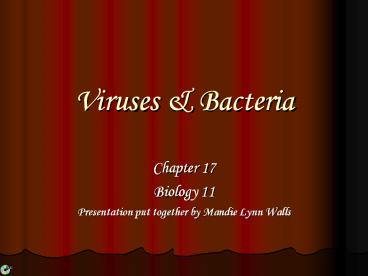Viruses & Bacteria - PowerPoint PPT Presentation
Title:
Viruses & Bacteria
Description:
Viruses & Bacteria Chapter 17 Biology 11 Presentation put together by Mandie Lynn Walls What are Viruses A virus is a non-cellular particle made up of genetic ... – PowerPoint PPT presentation
Number of Views:78
Avg rating:3.0/5.0
Title: Viruses & Bacteria
1
Viruses Bacteria
- Chapter 17
- Biology 11
- Presentation put together by Mandie Lynn Walls
2
What are Viruses
- A virus is a non-cellular particle made up of
genetic material and protein that can invade
living cells.
3
T4 Bacteriophage
4
Herpes Virus
5
Escherichia Coli Bacterium
- E. coli is a bacterium. That is a crude cell, it
is not a virus because viruses are protein
containers with DNA cores or RNA cores.
6
E. Coli and the Bacteriophage
- What it looks like in real life
7
The Structure Of a Virus
- Viruses are composed of a core of nucleic acid
- The Nucleic acid core is surrounded by a protein
coat called a capsid - The Nucleic core is either made up of DNA or RNA
but never both
8
Cycle of Lytic and Lysogenic
9
Vaccines
- Viruses grown on chicken embryos are attenuated
vaccines - Another type of vaccine is made by heat killing
the virus
10
Retrovirus
- Change DNA into RNA.
- Example of a Retrovirus is HIV
11
- A typical, "minimal" retrovirus consists of
- an outer envelope which was derived from the
plasma membrane of its host - many copies of an envelope protein embedded in
the lipid bilayer of its envelope - a capsid a protein shell containing
- two molecules of RNA and
- molecules of the enzyme reverse transcriptase
12
Bacteria Cell
13
Prokaryotes
- Cells that do not have a nucleus
- Exist almost every where on earth
- Grow in numbers so great you can see them with
the unaided eye - Are placed in either the Eubacteria or the
Archebacteria Kingdoms - Make up the smaller of the two kingdoms
14
(No Transcript)
15
Eubacteria
- Make up the larger of the two prokaryote kingdoms
- Generally are surrounded by a cell wall composed
of complex carbohydrates
16
Cyanobacteria
- Photosynthetic bacterium
- Bluish-greenish color
- Contain membranes that carry out the process of
photosynthesis - Do not contain the same type of chloroplasts as
plants do - This bluish-greenish algae can be found nearly
everywhere on earth. - Can survive in extremely hot environments and
even extremely cold environment
17
Archaebacteria
- Lack important carbohydrate found in cell walls
- Have different lipids in their cell membrane
- Different types of ribosomes
- Very different gene sequences
- Archaebacteria can live in extremely harsh
environments - They do not require oxygen and can live in
extremely salty environments as well as extremely
hot environments.
18
Identifying Prokaryotes
- Cell Shape
- Cell Wall
- Movement
19
Bacterium Shapes
- Cocci Sphere shaped bacteria
- Bacillus Rod shaped bacteria
- Spirrillium Spiral shaped bacteria
- Flagella Leg-like structures that help to propel
the bacterium.
20
Gram and Gram Bacterium Cell Walls
21
Cellular Walls
- Chemical nature of a cell wall can be determined
by Gram Staining - By finding out what color the cell produces when
it is gram stained you can figure out the type of
carbohydrates in the cell wall
22
Movement
- Flagella Tail like structure the whips around
to propel the bacterium - Cillia Miniature flagella surround the cell
that help to swim - Non motile Sticky cillia like structures that
keep the bacterium from moving
23
Flagella
24
(No Transcript)
25
Bacteria and their energy
- Autotrophs
- Chemotrophs
- Heterotrophs
26
Autotrophs
- Make their own energy
- Using Solar energy
- Eg. Cyanobacteria
27
Chemotrophs
- Make own Energy
- Using Chemical energy
- Eg. Archaebacteria
28
Heterotrophs
- Obtain food
- By eating
- Eg. E-coli
29
Bacteria Respiration
- Live without Oxygen
- Can live with or without oxygen
- Cannot live without oxygen.
- Obligate Anaerobes
- Facultative Anaerobes
- Obligate Aerobes
30
Bacteria Reproduction
- Binary Fission
- Conjugation
- Spore Formation
31
Cellular organism copies its genetic information
then splits into two identical daughter cells
32
Conjugation
- A type of Bacteria Sex
- Two organism swap genetic information, that
contains the information such as a resistance to
penicillin
33
Spore Formation Endospore
- A type of dormant cell
- Exhibit no signs of life
- Highly resistant to environmental stresses such
as - -High temperatures
- -Irradiation
- -Strong acids
- -Disinfectants
- Endospores are formed by vegetative cells in
response to environmental signals that indicate a
limiting factor for vegetative growth, such as
exhaustion of an essential nutrient.
34
Symbiosis
- Close relationship between to species in which at
least one species benefits from the other - Live together for LIFE
35
Parasitism
- Bacteria exploit the host cell, injuring them
- Eg. Mychobacterium tuberculosis
36
Mutualism
- Symbiosis in which two of the species live
together in such a way that both benefit from the
relationship - Eg. E-coli
37
Nitrogen Fixations
- Process by which nitrogen in the atmosphere is
converted into a form that can be used by living
things
38
THE END
39
This powerpoint was kindly donated to
www.worldofteaching.com http//www.worldofteac
hing.com is home to over a thousand powerpoints
submitted by teachers. This is a completely free
site and requires no registration. Please visit
and I hope it will help in your teaching.































